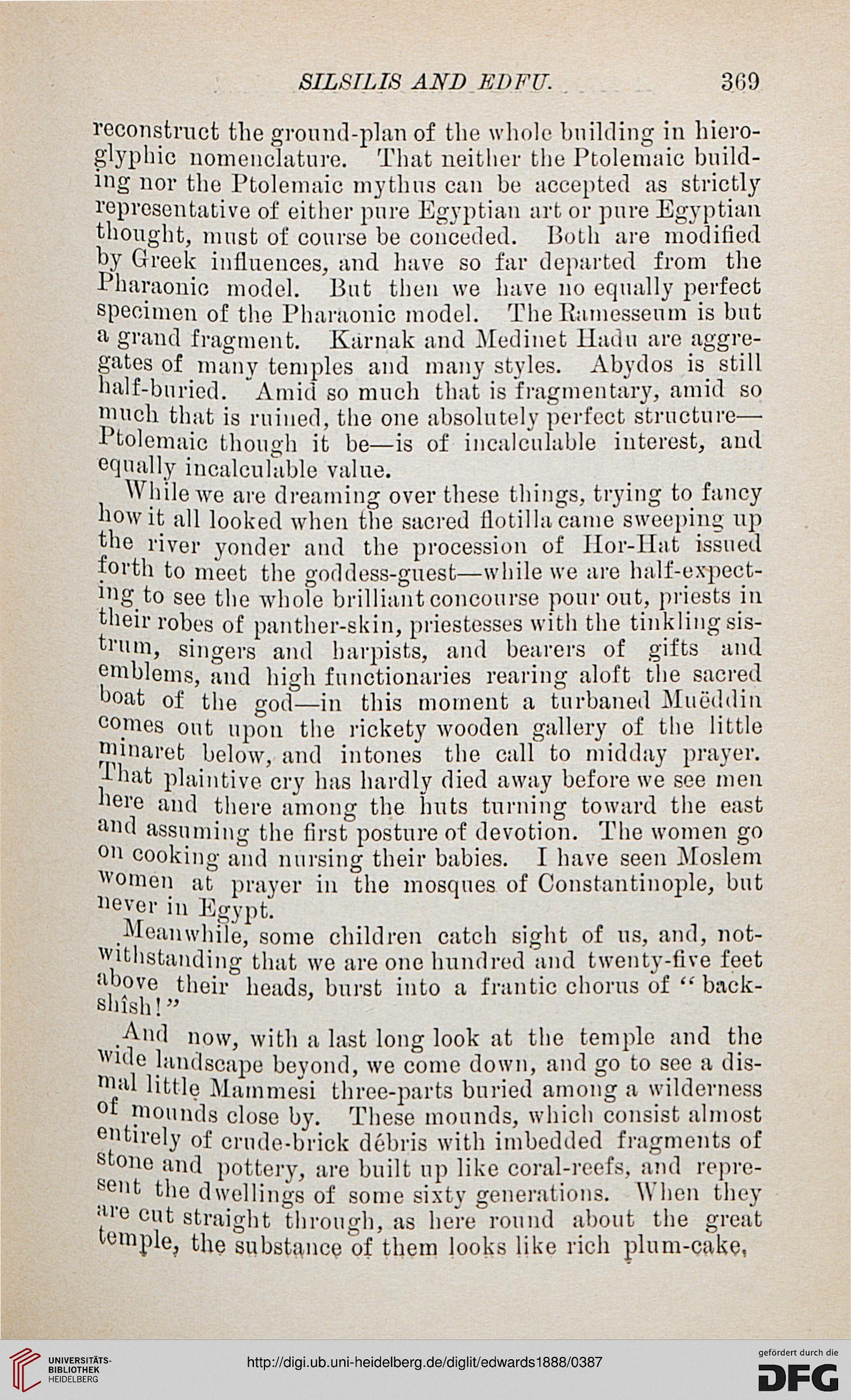SILSTLIS AND EDFU. 369
reconstruct the ground-plan of the whole building in hiero-
glyphic nomenclature. That neither the Ptolemaic build-
ing nor the Ptolemaic my thus can be accepted as strictly
representative of either pure Egyptian art or pure Egyptian
thought, must of course be conceded. Both are modified
by Greek influences, and have so far departed from the
Pharaonic model. But then we have no equally perfect
specimen of the Pharaonic model. The Ramesseum is but
a grand fragment. Karnak and Medinet Iladu are aggre-
gates of many temples and many styles. Abydos is still
half-buried. Amid so much that is fragmentary, amid so
much that is ruined, the one absolutely perfect structure—
Ptolemaic though it be—is of incalculable interest, and
equally incalculable value.
While we are dreaming over these things, trying to fancy
how it all looked when the sacred flotilla came sweeping up
the river yonder and the procession of Jlor-llat issued
forth to meet the goddess-guest—while we are half-expect-
mg to see the whole brilliant concourse pour out, priests in
their robes of panther-skin, priestesses with the tinkling sis-
"'um, singers and harpists, and bearers of gifts and
emblems, and high functionaries rearing aloft the sacred
boat of the god—in this moment a turbaned Mueddin
comes out upon the rickety wooden gallery of the little
minaret below, and intones the call to midday prayer,
f hat plaintive cry has hardly died away before we see men
bere and there among the huts turning toward the east
aml assuming the first posture of devotion. The women go
°'i cooking and nursing their babies. I have seen Moslem
women at prayer in the mosques of Constantinople, but
"ever in Egypt.
Meanwhile, some children catch sight of us, and, not-
withstanding that we are one hundred and twenty-five feet
"•hove their heads, burst into a frantic chorus of " back-
shish !"
And now, with a last long look at the temple and the
wide landscape beyond, we come down, and go to see a dis-
mal little Mammesi three-parts buried among a wilderness
ot mounds close by. These mounds, which consist almost
entirely of crude-brick debris with imbedded fragments of
stone and pottery, are built up like coral-reefs, and repre-
sent the dwellings of some sixty generations. When they
;u'e cut straight through, as here round about the great
temple, the substance "of them looks like rich plum-cake,
reconstruct the ground-plan of the whole building in hiero-
glyphic nomenclature. That neither the Ptolemaic build-
ing nor the Ptolemaic my thus can be accepted as strictly
representative of either pure Egyptian art or pure Egyptian
thought, must of course be conceded. Both are modified
by Greek influences, and have so far departed from the
Pharaonic model. But then we have no equally perfect
specimen of the Pharaonic model. The Ramesseum is but
a grand fragment. Karnak and Medinet Iladu are aggre-
gates of many temples and many styles. Abydos is still
half-buried. Amid so much that is fragmentary, amid so
much that is ruined, the one absolutely perfect structure—
Ptolemaic though it be—is of incalculable interest, and
equally incalculable value.
While we are dreaming over these things, trying to fancy
how it all looked when the sacred flotilla came sweeping up
the river yonder and the procession of Jlor-llat issued
forth to meet the goddess-guest—while we are half-expect-
mg to see the whole brilliant concourse pour out, priests in
their robes of panther-skin, priestesses with the tinkling sis-
"'um, singers and harpists, and bearers of gifts and
emblems, and high functionaries rearing aloft the sacred
boat of the god—in this moment a turbaned Mueddin
comes out upon the rickety wooden gallery of the little
minaret below, and intones the call to midday prayer,
f hat plaintive cry has hardly died away before we see men
bere and there among the huts turning toward the east
aml assuming the first posture of devotion. The women go
°'i cooking and nursing their babies. I have seen Moslem
women at prayer in the mosques of Constantinople, but
"ever in Egypt.
Meanwhile, some children catch sight of us, and, not-
withstanding that we are one hundred and twenty-five feet
"•hove their heads, burst into a frantic chorus of " back-
shish !"
And now, with a last long look at the temple and the
wide landscape beyond, we come down, and go to see a dis-
mal little Mammesi three-parts buried among a wilderness
ot mounds close by. These mounds, which consist almost
entirely of crude-brick debris with imbedded fragments of
stone and pottery, are built up like coral-reefs, and repre-
sent the dwellings of some sixty generations. When they
;u'e cut straight through, as here round about the great
temple, the substance "of them looks like rich plum-cake,




